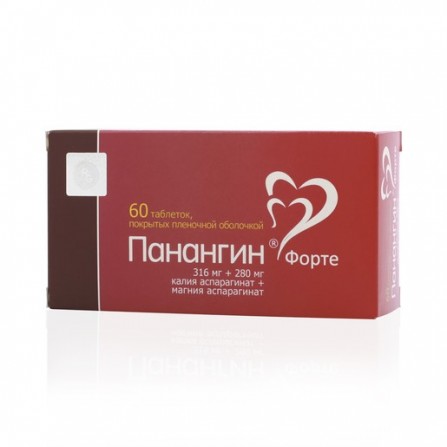Panangin Forte Tablets film coated N60
Condition: New product
980 Items
Rating:
Be the first to write a review!

More info
Active ingredients
Potassium and magnesium asparaginate
Release form
Pills
Composition
Potassium asparaginata hemihydrate 332.6 mg which corresponds to the content of potassium asparaginata 316 mgmagniya asparaginata tetrahydrate 350 mg, which corresponds to the content asparaginata magnesium 280 mgvspomogatelnye ingredients: corn starch - 172.2 mg Talc - 20 mg of magnesium stearate - 8 mg potato starch - 6.6 mg Povidone k30 - 6.6 mg, colloidal silicon dioxide - 4 mg. film coating composition: talc - 7.3 mg, butyl methacrylate copolymer - 6 mg, titanium dioxide (color index: ci 77891, e171) - 5.3 mg, macrogol 6000 - 1.4 mg
Pharmacological effect
The most important intracellular cations K + and Mg ++ play a key role in the functioning of numerous enzymes, in the formation of bonds between macromolecules and intracellular structures and in the mechanism of muscle contractility. The intracellular and extracellular ratio of potassium, calcium, sodium and magnesium ions affects myocardial contractility. Endogenous aspartate acts as a conductor of ions: has a high affinity for cells, due to the insignificant dissociation of its salts, ions in the form of complex compounds penetrate into the cell. Magnesium and potassium aspartate improve myocardial metabolism. Magnesium / potassium deficiency predisposes to the development of hypertension, atherosclerosis of the coronary arteries, arrhythmias and metabolic changes in the myocardium. Each tablet of Panangin Forte contains 280 mg of magnesium asparaginate and 316 mg of potassium asparaginate, which is 2 times higher than the content of active ingredients in Panangin, pills film-coated. The daily dose of Panangin Forte (1 tablet 3 times a day) corresponds to the daily dose of Panangin (2 pills 3 times a day). Take a single dose of the drug Panangin Forte in the form of a single tablet makes the treatment more convenient for the patient.
Pharmacokinetics
Absorption Calium and magnesium asparaginates are intensively absorbed in the intestine, mainly in the small intestine. Withdrawal By the kidneys.
Indications
To eliminate the deficiency of potassium and magnesium in the combination therapy in: Various manifestations of coronary heart disease (including acute myocardial infarction). Chronic heart failure. Disorders of heart rhythm (including arrhythmias caused by an overdose of cardiac glycosides).
Contraindications
Hypersensitivity to any of the components of the drug. Acute and chronic renal failure. Hyperkalemia. Hypermagneemia. Addison's disease. Atrioventricular block I-III degree. Shock, including cardiogenic (blood pressure less than 90 mm Hg). Disruption of amino acid metabolism. Severe Myasthenia Hemolysis. Acute metabolic acidosis. Dehydration condition. Age 18 years (efficacy and safety not established). With caution: Pregnancy (especially in the first trimester). Breastfeeding period.
Precautionary measures
Before use, you should consult with your doctor. Patients with diseases accompanied by hyperkalemia require special attention: regular monitoring of ionograms is necessary. Impact on ability to drive vehicles and control mechanisms No studies have been conducted. It is not expected to affect the ability to drive and to work with mechanisms that require increased concentration of attention and speed of psychomotor reactions.
Use during pregnancy and lactation
Application is possible if the potential benefit to the mother outweighs the possible risk to the fetus. Calia and magnesium asparaginat pass into breast milk. If necessary, taking the drug during lactation, breastfeeding should be stopped.
Side effects
Possible - nausea, vomiting, diarrhea, discomfort or burning in the pancreas area (in patients with anacid gastritis or cholecystitis), atrioventricular block, paradoxical reaction (increase in the number of extrasystoles), hyperkalemia (nausea, vomiting, diarrhea, paresthesia, hypermagia (last). thirst, lowering blood pressure, hyporeflexion, respiratory depression, convulsions). If any of the listed adverse reactions become serious, or you notice the appearance of adverse reactions that are not listed in this You must consult your doctor.
Overdose
Symptoms of hyperkalemia: fatigue, myasthenia, paresthesia, confusion, heart rhythm disturbances (bradycardia, atrioventricular block, arrhythmias, cardiac arrest), hypermagneemia symptoms: reduction of neuromuscular blockade, arrhythmias, cardiac arrest). lowering blood pressure.With a sharp increase in the content of magnesium ions in the blood: inhibition of deep tendon reflexes, respiratory paralysis, coma. Treatment: intravenous calcium chloride, if necessary - hemodialysis.
Interaction with other drugs
Pharmacology hilokaliemia caused by the latter. potassium reduces the unwanted effects of cardiac glycosides. Panangin Forte enhances the negative dromo-and bathmotropic action of antiarrhythmic drugs. Magnium reduces the effect of neomycin, polymyxin B, tetracycline and streptomycin. Anesthetics increase the inhibitory effect of magnesium preparations on CHS; with simultaneous use with agrauronium, decametonium, succinyl chloride and suxametonium, an increased neuromuscular blockade is possible; calcitriol increases the magnesium content in the blood plasma, calcium preparations reduce the effect of magnesium preparations.




